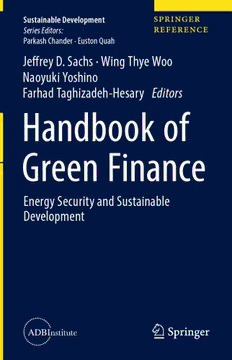
Handbook of Green Finance PDF
Preview Handbook of Green Finance
Sustainable Development Series Editors: Parkash Chander · Euston Quah Jeffrey D. Sachs · Wing Thye Woo Naoyuki Yoshino Farhad Taghizadeh-Hesary Editors Handbook of Green Finance Energy Security and Sustainable Development Sustainable Development SeriesEditors ParkashChander JindalSchoolofGovernmentandPolicy NewDelhi,India EustonQuah NanyangTechnologicalUniversity Singapore,Singapore TheMRWSeriesonSustainableDevelopmentexploresandexaminesarangeofkey sustainability questions, right from the abstract concepts, definition, criteria, and approaches around the subject of Sustainable Development to the examination of moreconcreteissuesfrompoliciesandpractices.Throughvariousvolumeslooking attheglobalscenarioingeneralandAsiaPacificinparticular,theseriesintroduces economic tools in sustainability, including cost-benefit analysis, environmental impactassessment,economicappraisaltechniques,methodstodealwithuncertainty andrisks,andothermethodstoevaluatetheimpactsofpolicyinstrumentsappliedby governments to sustainability issues. Finally, theseriesadvocates best practices on the part of produces, consumers, and governments, while charting the future for sustainability. Moreinformationaboutthisseriesathttp://www.springer.com/series/15042 (cid:129) Jeffrey D. Sachs Wing Thye Woo Naoyuki Yoshino Farhad Taghizadeh-Hesary Editors Handbook of Green Finance Energy Security and Sustainable Development With143Figuresand133Tables Editors JeffreyD.Sachs WingThyeWoo ColumbiaUniversity DepartmentofEconomics NewYork,NY,USA UniversityofCaliforniaatDavis Davis,CA,USA NaoyukiYoshino FarhadTaghizadeh-Hesary AsianDevelopmentBankInstitute(ADBI) FacultyofPoliticalScienceandEconomics KeioUniversity WasedaUniversity Tokyo,Japan Tokyo,Japan ISBN978-981-13-0226-8 ISBN978-981-13-0227-5(eBook) ISBN978-981-13-0228-2(printandelectronicbundle) https://doi.org/10.1007/978-981-13-0227-5 ©AsianDevelopmentBankInstitute2019 Thisworkissubjecttocopyright.AllrightsarereservedbythePublisher,whetherthewholeorpartofthe materialisconcerned,specificallytherightsoftranslation,reprinting,reuseofillustrations,recitation, broadcasting,reproductiononmicrofilmsorinanyotherphysicalway,andtransmissionorinformation storageandretrieval,electronicadaptation,computersoftware,orbysimilarordissimilarmethodology nowknownorhereafterdeveloped. Theuseofgeneraldescriptivenames,registerednames,trademarks,servicemarks,etc.inthispublication doesnotimply,evenintheabsenceofaspecificstatement,thatsuchnamesareexemptfromtherelevant protectivelawsandregulationsandthereforefreeforgeneraluse. Thepublisher,theauthors,andtheeditorsaresafetoassumethattheadviceandinformationinthisbook arebelievedtobetrueandaccurateatthedateofpublication.Neitherthepublishernortheauthorsorthe editorsgiveawarranty,expressorimplied,withrespecttothematerialcontainedhereinorforanyerrors oromissionsthatmayhavebeenmade.Thepublisherremainsneutralwithregardtojurisdictionalclaims inpublishedmapsandinstitutionalaffiliations. ThisSpringerimprintispublishedbytheregisteredcompanySpringerNatureSingaporePteLtd. The registered company address is: 152 Beach Road, #21-01/04 Gateway East, Singapore 189721, Singapore Series Preface The term “sustainable development” – first coined by former Norwegian Prime Minister Harlem Brundtland in 1987 in the World Commission on Environment andDevelopmentreport–hasbeenusedandmisusedovertheyearstojustifymany actions or causes. Sustainability, in the context of that report, is defined as “devel- opmentthatmeetstheneedsofthepresentwithoutcompromisingtheabilityofthe futuretomeettheirown.”Thisconcept,whilenobleandcaringfortheenvironment and that for the future generation, has however come to mean different things to different people. To some, it implies a greater awareness of environmental issues, whiletoothersitmeansacoordinated,organized,andsystematicevaluativetheory foreconomicandpublicpolicy.Muchintellectualdebateonsustainabilityalsostems from whether society allows for substitution between natural capital (green areas, fossilfuels,andforests)andman-madecapital(buildingsandotherinfrastructure)in thecourseofeconomicgrowthanddevelopment.Stillotherswouldbehappywith efforts to measure sustainability by way of human progress, welfare, and income growth. For much of environmental management, one clear focus is to achieve environmentalqualitybyreducingman-madepollutiontoalevelthatisacceptable tosociety. Inall,sustainabilityisanebulousbutattractiveconceptwithanimportantguiding principleand essentiallyasks thebasic questionfor anyactivity: “Can thisactivity continue?” There exists many works on sustainability, most of which are related to global sustainability,aswellassustainabilityintheWesternworld.Incontrast,manyAsian countries arestill prioritizing strong,yetpossiblyunsustainable, economicgrowth. Majority of these developing Asian countries are economically far behind the developed world. Some of these countries are experiencing pockets of abject pov- erty, struggling to meet the needs of the present in areas such as sanitation and education.Itisevidentthatstrongeconomicgrowthremainsparamounttoimprov- ing living standards in many Asian regions, but we cannot overlook the fact that growthcarriesitsowncoststothenaturalenvironmentandtopeoples’health.The truesuccessofgrowththushingesonwhether“sustainabledevelopment”hasbeen achievedandwhetherAsiancountriesareabletobalancethetwingoalsofeconomic growthandenvironmentalprotection. v vi SeriesPreface TheMRWseriesonSustainableDevelopmentexploresandexaminesarangeof sustainabilityquestionsasfollows,witheachbookdealingwithaparticulartopic. 1. Theoriginsanddefinitions/meaningsoftheterm“sustainabledevelopment”;the relationship between sustainability and economic efficiency/growth; sustain- ability theories and models; sustainability criteria including concepts of weak and strong sustainability; other key conditions required to achieve sustainable development;approachestomeasuringsustainability. 2. Therolesofvariouseconomicagentsinsustainabledevelopment.Whatcanand whatshouldproducers,consumers,andgovernmentsdo? 3. How has sustainability policies and measures been implemented in developed economies?WhatarethelessonsforAsia? 4. HowdoessustainabilityfeatureintheAsianenvironment?Howissustainability perceived and understood by Asian countries? What has the region achieved thusfar?Whatarethestrengthsorweaknesses/limitationsofcurrentlyadopted policiesandapproaches? 5. Economictoolsinsustainability,includingcost-benefitanalysis,environmental impactassessment,economicappraisaltechniques,methodstodealwithuncer- taintyandrisks,andothermethodstoevaluatetheimpactsofpolicyinstruments appliedbygovernmentstosustainabilityissues. 6. International policies and sustainability, including international institutions to resolvesustainabilityrelatedissues,andthehistoryofinternationalnegotiations, agreements,andactions. 7. Charting the future for sustainability: What lies ahead? What are the future challenges,newsolutions,andtechnologicalinnovations? 8. Sustainabilityinmegacities. 9. Balancing environment and economic growth, including the complexity of sustainabledevelopmentintheAsiancontext. 10. Climatechangeandinternationalagreementstotackleit. 11. TheproblemofSoutheastAsiahazeanditspossiblesolutions. 12. Economicinstrumentsandmechanismsforachievingsustainabilityandrelated goals. Audience Practitioners;governmentpolicymakers;industryspecialists;university students,researchers,andfacultymemberstakingcoursesonenvironment,resource management,ecology,economics,environmentalscience,urbanandresourceplan- ning,etc.;NGOs;andothers. JindalSchoolofGovernmentandPublic ParkashChander Policy,NCR Sonipat,Haryana,India DepartmentofEconomics EustonQuah NanyangTechnologicalUniversity Singapore,Singapore Preface Given the current trajectory of global fossil fuel use, the projected increase in the temperatureoftheplanetwillbecatastrophicforfoodproduction,humanhealth,and biodiversity. Indeed, in many parts of the world it will threaten the survival of communities. Governments have already agreed to keep global warming below 2 (cid:1)C but have yet to take decisive action toward creating a low-carbon energy system. Theworldneedsmassiveinvestmentsingreenenergysystems,andphasingout ofcoal-firedpowerplants.Inaddition,itneedsconsiderableinvestmentsinelectric vehiclestogetherwithasharpreductionininternalcombustionenginevehicles. However, new investments in green energy projects and energy efficiency have sloweddown.Theprivatesectorisnotshowingsufficientinterestingreenprojects becauseoftheirhigherrisksandlowerratesofreturnwhencomparedwithfossilfuel projects. This means that achieving the Sustainable Development Goals (SDGs) will require the establishment of new financial schemes for green projects. For “Green Finance”tosucceed,governmentswillhavetointroducepoliciestoincreaseratesof returnofgreenprojectsinordertoincentivizeprivateinvestorstoinvestinthem. TheHandbookofGreenFinance:EnergySecurityandSustainableDevelopment bringstogetherleadingscholars,policy-makers,andpractitionerstodiscussoptions instrategiesandpolicyinstrumentsinapolicy-orientedapproachongreenfinance. Thehandbookconsistsof12parts. Part1isfortheintroduction,whichshowstheimportanceofGreenFinancefor achieving sustainable development goals and energy security. Parts 2-11 are for financial barriers for the development of green projects, green energy transition (strategiesandfinancialgovernance),creditriskandcreditratingofgreenprojects, green bonds, carbon capture and carbon pricing, role of banks and non-bank financial institutions, fintech and financial innovation, green technology financing, community-basedgreenfinance,andtheroleoffiscalpolicy.These10partsprovide 19 thematic works that show practical methods (financial and nonfinancial) for promoting private sector investments in green projects. Part 12 contains country case studies to identify the barriers and solutions to green finance. The countries covered are Australia and New Zealand, Bangladesh, India, Indonesia, Malaysia, Pakistan, the Republic of Korea, Singapore, and Viet Nam. The comparison of vii viii Preface country experiences provides valuable lessons on how to utilize green finance to acceleratethemovetoacarbon-freeworld. This handbook is an essential source for researchers, government officials, students,andprofessionalsworkinginthefinancialmarketandenergysector. JeffreyD.Sachs WingThyeWoo NaoyukiYoshino FarhadTaghizadeh-Hesary Acknowledgments WearegratefultoPeterJ.MorganandBihongHuangfortheirhelpinthisresearch project from the ADBI side, Ainslie Smith for coordinating the copyediting of the chapters, Muriel S. Ordoñez and Jera Lego for publication management, Grant Stillmanforlegalaffairsmanagement,andMasaeIkedaforsecretarialsupport.We also thank Juno Kawakami, Krithika Radhakrishnan, and TinaShelton of Springer Naturefortheirhelpandeffortsinthebookpublishingprocess. Wearegratefultoallcontributorstothisbook.Withouttheirvaluablecontribu- tions,wewouldhavenotbeenabletofinalizethisbook. ix
